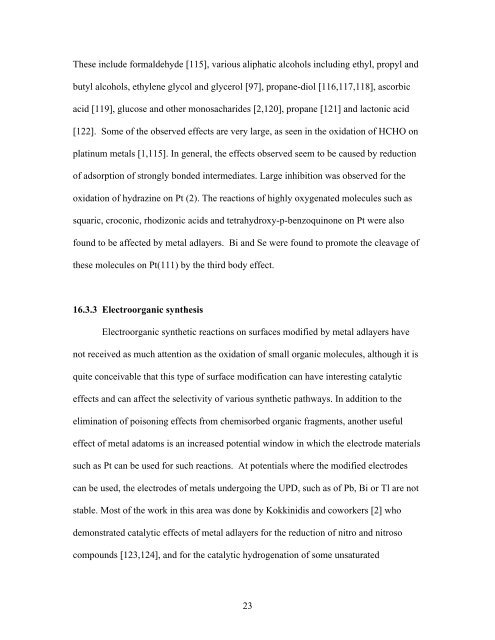electrocatalysis on surfaces modified... - Brookhaven National ...
electrocatalysis on surfaces modified... - Brookhaven National ...
electrocatalysis on surfaces modified... - Brookhaven National ...
You also want an ePaper? Increase the reach of your titles
YUMPU automatically turns print PDFs into web optimized ePapers that Google loves.
These include formaldehyde [115], various aliphatic alcohols including ethyl, propyl and<br />
butyl alcohols, ethylene glycol and glycerol [97], propane-diol [116,117,118], ascorbic<br />
acid [119], glucose and other m<strong>on</strong>osacharides [2,120], propane [121] and lact<strong>on</strong>ic acid<br />
[122]. Some of the observed effects are very large, as seen in the oxidati<strong>on</strong> of HCHO <strong>on</strong><br />
platinum metals [1,115]. In general, the effects observed seem to be caused by reducti<strong>on</strong><br />
of adsorpti<strong>on</strong> of str<strong>on</strong>gly b<strong>on</strong>ded intermediates. Large inhibiti<strong>on</strong> was observed for the<br />
oxidati<strong>on</strong> of hydrazine <strong>on</strong> Pt (2). The reacti<strong>on</strong>s of highly oxygenated molecules such as<br />
squaric, croc<strong>on</strong>ic, rhodiz<strong>on</strong>ic acids and tetrahydroxy-p-benzoquin<strong>on</strong>e <strong>on</strong> Pt were also<br />
found to be affected by metal adlayers. Bi and Se were found to promote the cleavage of<br />
these molecules <strong>on</strong> Pt(111) by the third body effect.<br />
16.3.3 Electroorganic synthesis<br />
Electroorganic synthetic reacti<strong>on</strong>s <strong>on</strong> <strong>surfaces</strong> <strong>modified</strong> by metal adlayers have<br />
not received as much attenti<strong>on</strong> as the oxidati<strong>on</strong> of small organic molecules, although it is<br />
quite c<strong>on</strong>ceivable that this type of surface modificati<strong>on</strong> can have interesting catalytic<br />
effects and can affect the selectivity of various synthetic pathways. In additi<strong>on</strong> to the<br />
eliminati<strong>on</strong> of pois<strong>on</strong>ing effects from chemisorbed organic fragments, another useful<br />
effect of metal adatoms is an increased potential window in which the electrode materials<br />
such as Pt can be used for such reacti<strong>on</strong>s. At potentials where the <strong>modified</strong> electrodes<br />
can be used, the electrodes of metals undergoing the UPD, such as of Pb, Bi or Tl are not<br />
stable. Most of the work in this area was d<strong>on</strong>e by Kokkinidis and coworkers [2] who<br />
dem<strong>on</strong>strated catalytic effects of metal adlayers for the reducti<strong>on</strong> of nitro and nitroso<br />
compounds [123,124], and for the catalytic hydrogenati<strong>on</strong> of some unsaturated<br />
23
















